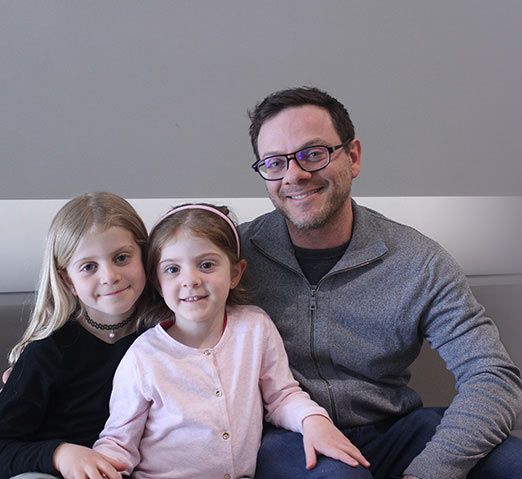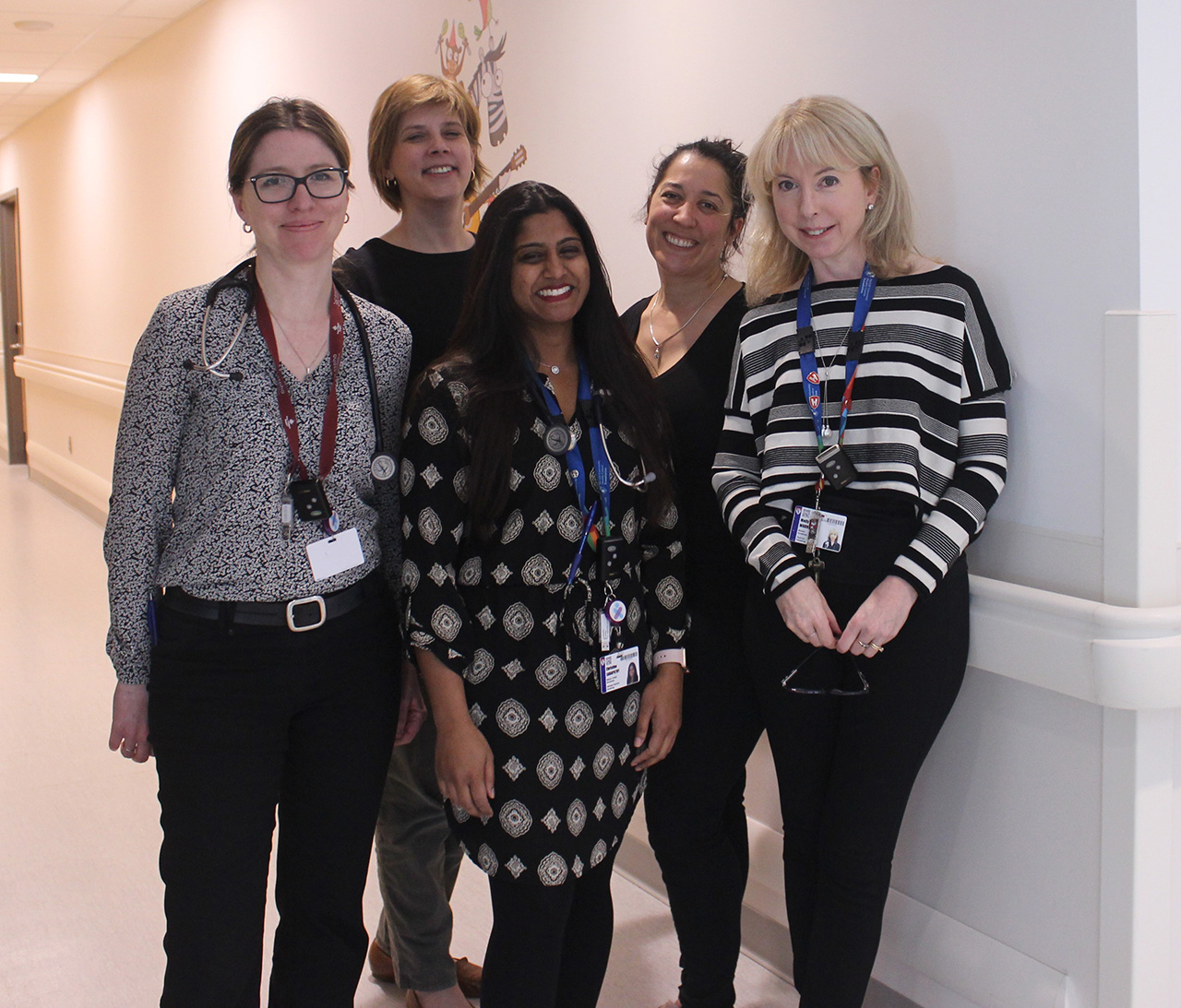For hemophiliacs, the best treatment happens at home
From babies to adults, the Hemophilia Treatment Centre of the MUHC prepares patients for home therapy so they can lead a full, active life
When he was three years old, Christian Zereik bit his tongue. The bleeding wouldn’t stop, so he was taken to a hospital for a blood transfusion and some tests. The diagnosis: severe hemophilia B. Like other congenital bleeding disorders, hemophilia runs in families: a mutated gene carried in the X chromosome prevents the blood from clotting, causing people to bleed after injury or surgery, and sometimes spontaneously. Bleeding within the joints or soft tissue can lead to intense pain and arthritis. Bleeding in the brain can cause seizures and paralysis and even death.

The disease affects mostly boys. Since males inherit the X chromosome from their mothers and the Y chromosome from their fathers, baby boys who receive a mutated gene will have a 50 percent chance of becoming hemophiliacs.
Christian’s two daughters, Lexie and Annie, also carry the mutated gene and are considered as having mild hemophilia.
“When she was two, Lexie fell off the couch and hit her head; she ended up with a bleed between her brain and her skull. It was the worse day of my life. But we reacted quickly, as did the teams at the Montreal Children’s Hospital, so she recovered completely.”
The family is treated at the Hemophilia Treatment Centre of the McGill University Health Centre (MUHC), one of the four clinics in Quebec treating both adults and children with congenital bleeding disorders.
“When she was two, Lexie fell off the couch and hit her head; she ended up with a bleed between her brain and her skull. It was the worse day of my life. But we reacted quickly, as did the teams at the Montreal Children’s Hospital, so she recovered completely.”
The family is treated at the Hemophilia Treatment Centre of the McGill University Health Centre (MUHC), one of the four clinics in Quebec treating both adults and children with congenital bleeding disorders.
“The care here has been phenomenal, from when I was a child to becoming an adult, to now, as a parent of two carriers and as an uncle to a boy with hemophilia. The people at the clinic are wonderful.”
“Hemophilia care is one of the best examples of medical care in the country,” says hematologist Dr. Margaret (Molly) Warner. “At the MUHC, we have a comprehensive team of experienced professionals, including hematologists, a dedicated nurse and a physiotherapist.”
Learning to treat themselves
The clinic also offers a nurse on call 24/7, but according to Dr. Warner, calls for help at night are rare.
“We teach patients to do prophylaxis – the regular infusion of clotting factor concentrates in order to prevent bleeding – intravenously at home, so they rarely have to come to the hospital,” she says. “The nurses in the centre teach parents to treat their young children within the first 18 months of life. When they are 12 to 14 years old, boys are sent to summer camp to learn how to treat themselves. Home therapy can convert a severe hemophiliac into a moderate one, allowing patients to live their lives with less risk of spontaneous bleeding.”

Christian adapts prophylaxis to his schedule, usually treating himself before major physical activities, such as playing sports or travelling.
“It increases my quality of life,” he says. “It elevates my factor level and gives me some protection. You never know what can happen when you’re hauling your luggage and carrying your kids around.”
Christian adapts prophylaxis to his schedule, usually treating himself before major physical activities, such as playing sports or travelling.
“It increases my quality of life,” he says. “It elevates my factor level and gives me some protection. You never know what can happen when you’re hauling your luggage and carrying your kids around.”
Lexi and Annie don’t do prophylaxis, but they may need treatment in the future, before a surgery or a dental procedure. Christian and his wife want their daughters to be active, but careful.
“We emphasize the need for helmets and tell them to be careful,” he says. “Because even though they are carriers, they can still bleed if they have an accident. At the same time, we want them to enjoy their activities, to enjoy life.”
A tragic history, full of twists
In 1999, Dr. Chris Tsoukas, director of Clinical Immunology at the MUHC and a key player in the establishment of an HIV treatment unit at the Montreal General Hospital, was appointed to the Order of Canada, for a career devoted to the research and treatment of HIV-AIDS. Together with Dr. Molly Warner, a hematologist at the MUHC, they remember key moments in the tragic and eventful history of hemophilia.
Until the mid-40s: hemophiliacs don’t live a normal lifespan: their only treatment is fresh frozen plasma, which doesn’t have an adequate dose of factor VIII (FVIII) or IX (FIX), so many die of bleeding complications.
1963: Frank Schnabel, an American-born Montrealer and businessman with severe hemophilia A, creates the World Federation of Hemophilia. Throughout his life, Schnabel, who was a patient of Dr. Tsoukas at the Montreal General Hospital, fought tirelessly for the rights of hemophiliacs around the world.
Late 1960s to early 1970s: cryoprecipitate, a frozen blood product, allows for a faster and more efficient administration of FVIII intravenously. But in the early 1980s, it becomes clear that both plasma and cryoprecipitate carry the risk of HIV and Hepatitis C (HCV) infection.
Late 1970s and early 1980s: plasma-derived FVIII and FIX concentrates made with pooled human blood become available. At first these products are a major breakthrough, allowing patients to treat at home. However, HIV and HCV are still unknown, so the plasma-derived products are untreated and untested for HIV/HCV. Around 80 percent of severe hemophiliacs become co-infected with these viruses, and many die of HIV throughout the 1980s.
Late 1970s: Dr. Hanna Strawczynski created the Hemophilia Treatment Centre (HTC) at the Montreal Children’s Hospital, based on the concept of comprehensive care. This was one of the first two comprehensive care centres in Canada. There are now 24 such centres, with dedicated MDs, nurses, physiotherapists and social workers delivering comprehensive care.
1985: HIV had been identified in 1983, so testing and heat-treating of blood products now prevent further HIV infections. HCV will only be discovered – and a test developed – in the late 1980s early 1990s, so hepatitis C continues to be a threat for hemophiliacs.
Early 1990s: To remove the risk of viral contamination, all FVIII and FIX products in Canada are switched to newly discovered recombinant products, which become used almost uniformly ever since.
An anonymous national database is created, allowing for the quick treatment of patients in emergency situations, no matter where they are.
The future: The treatment of hemophilia A and B may be on the brink of a positive change with the development of new products that can be administered in easier, more efficient ways, and the evolution of gene therapy for FIX deficiency.
